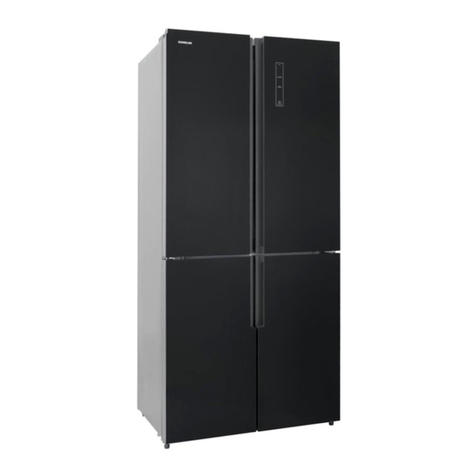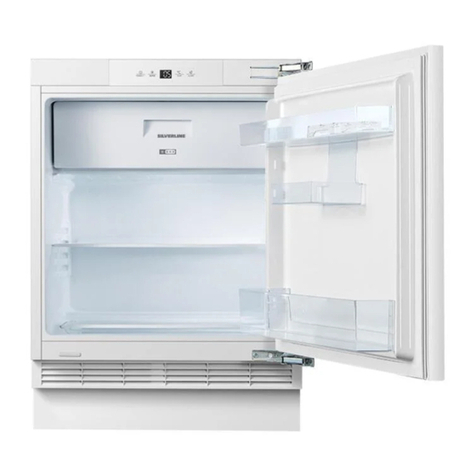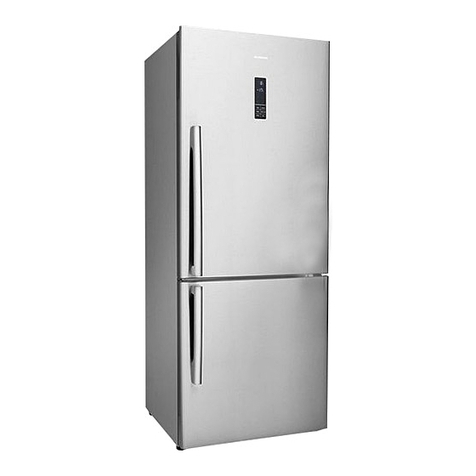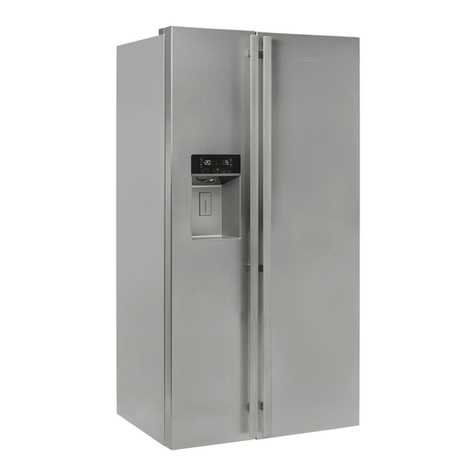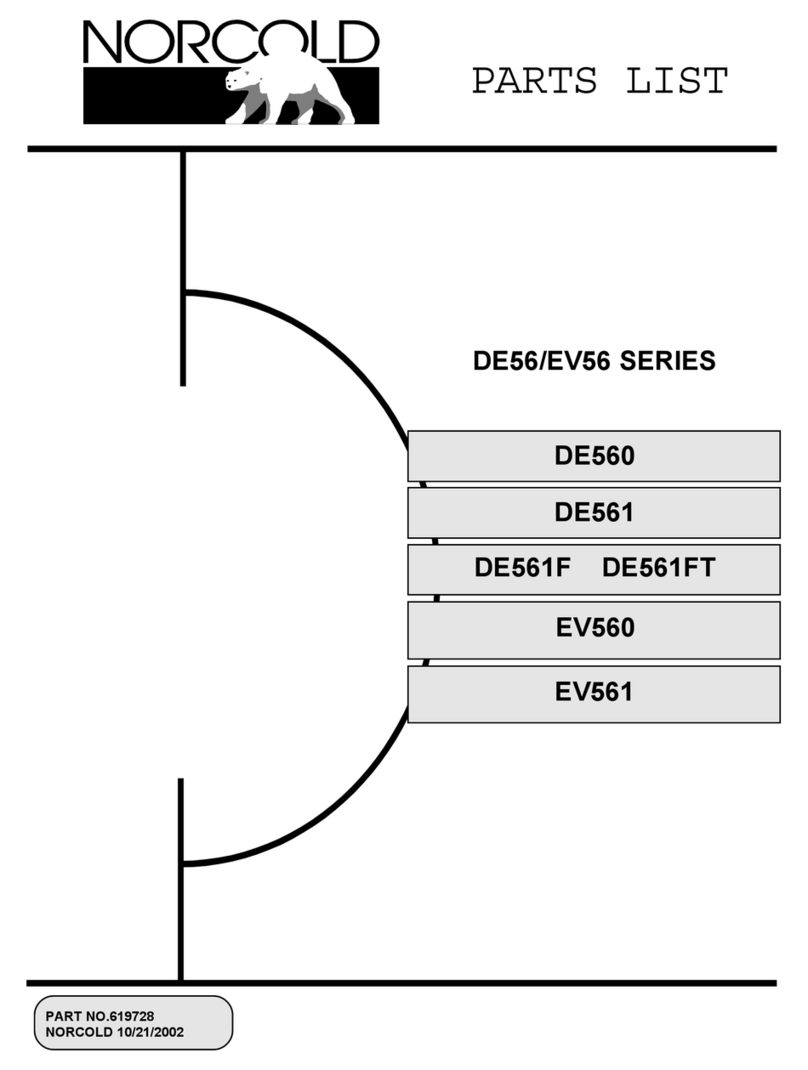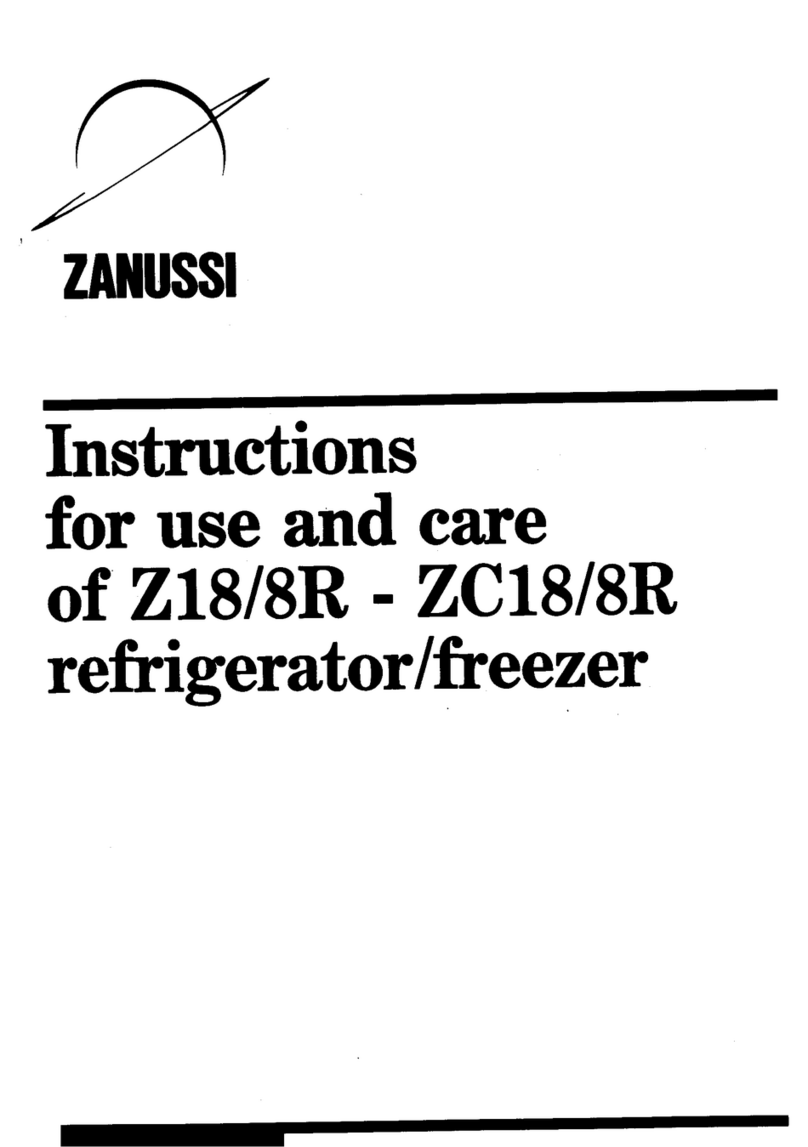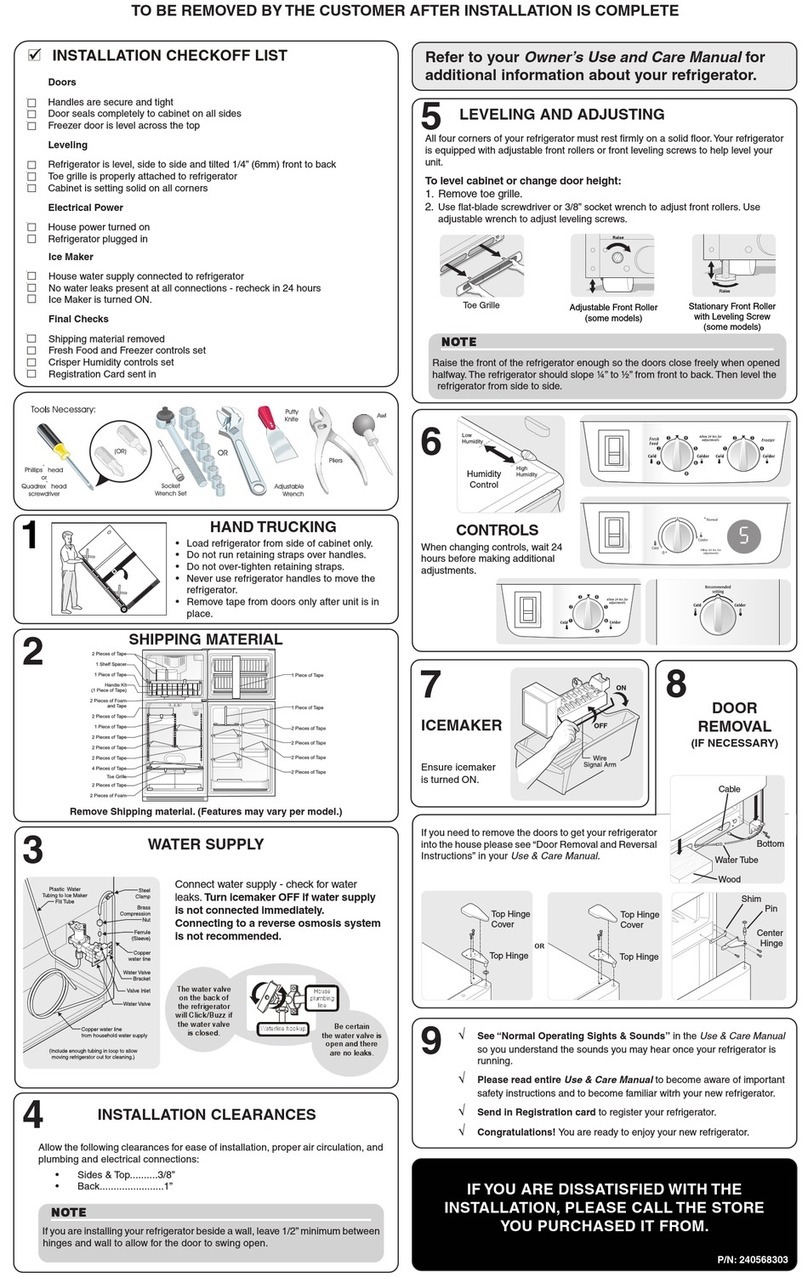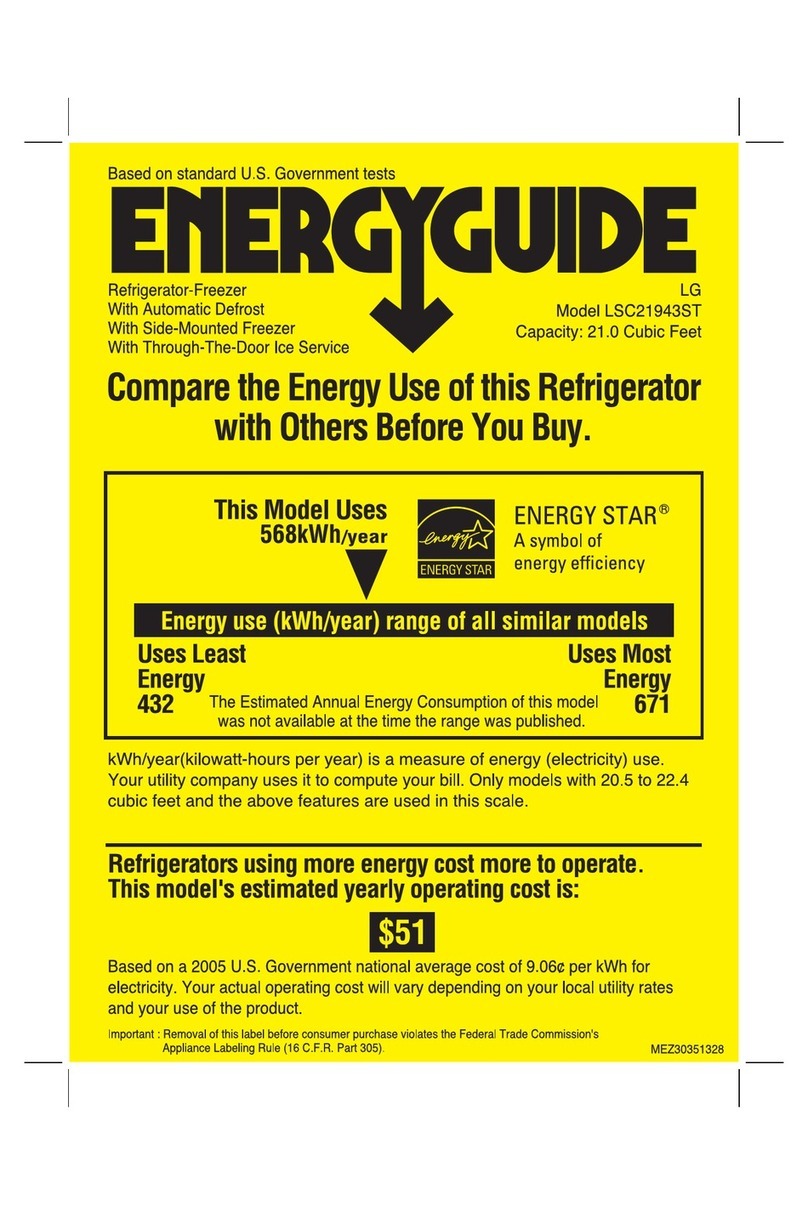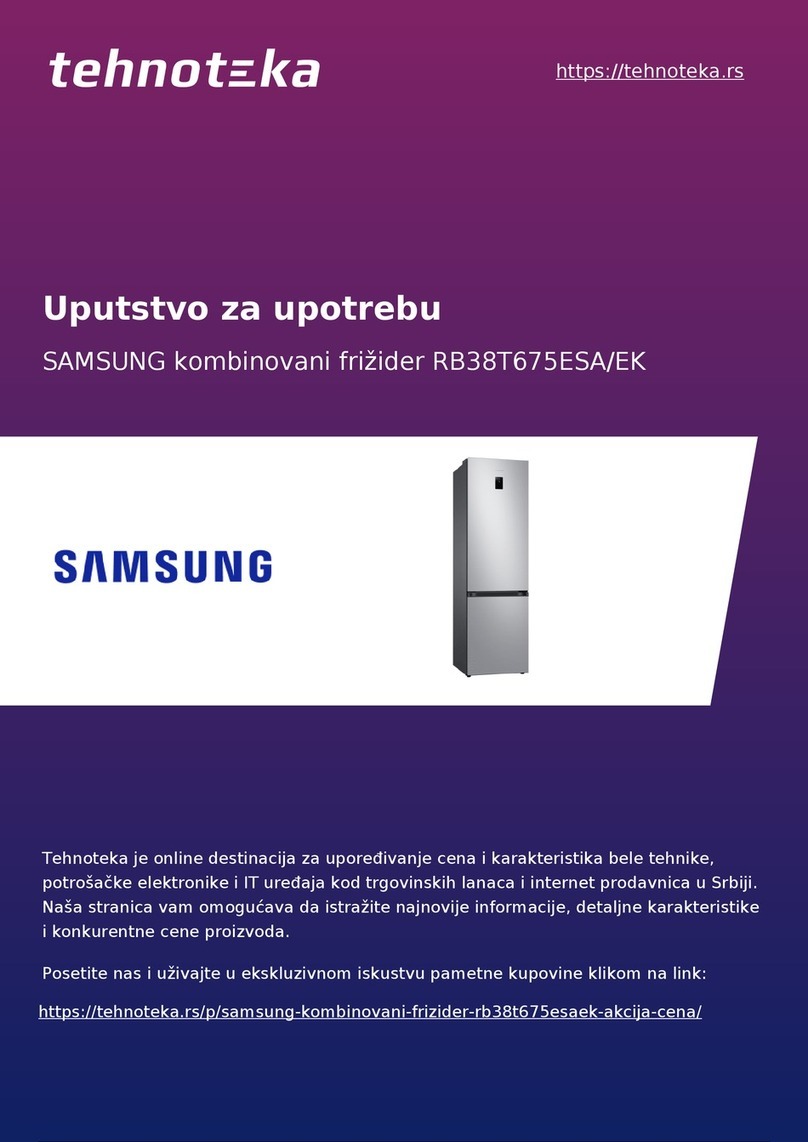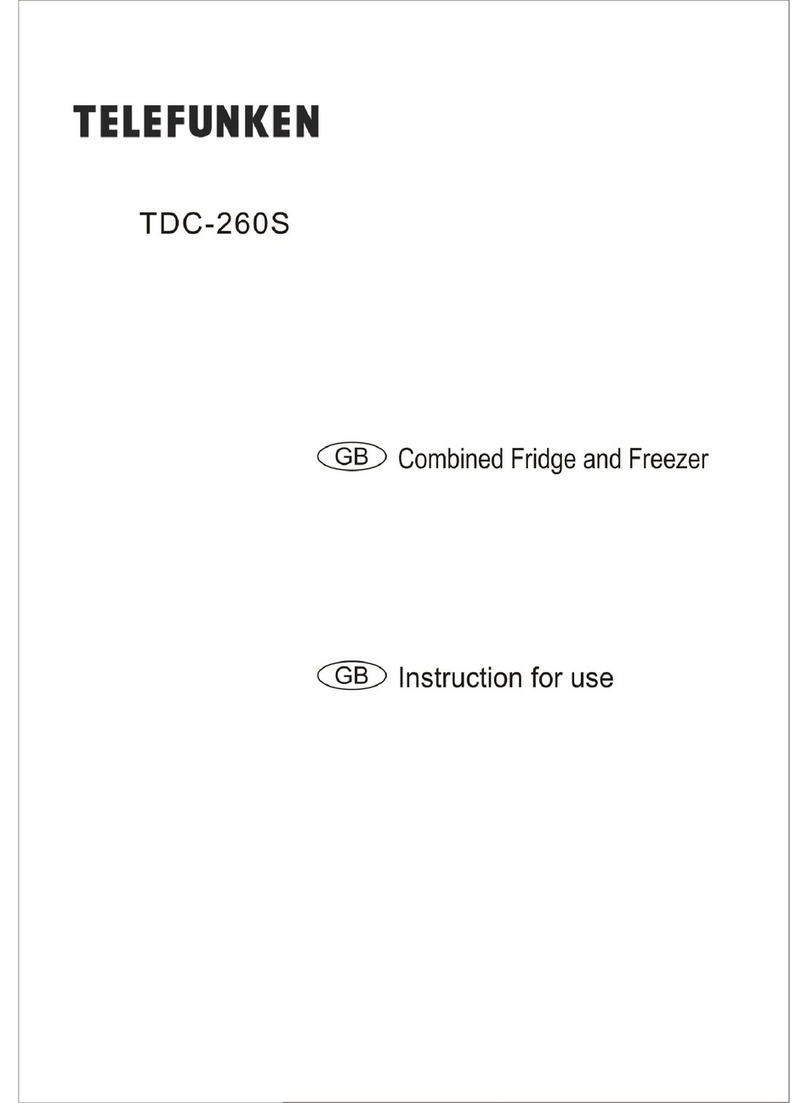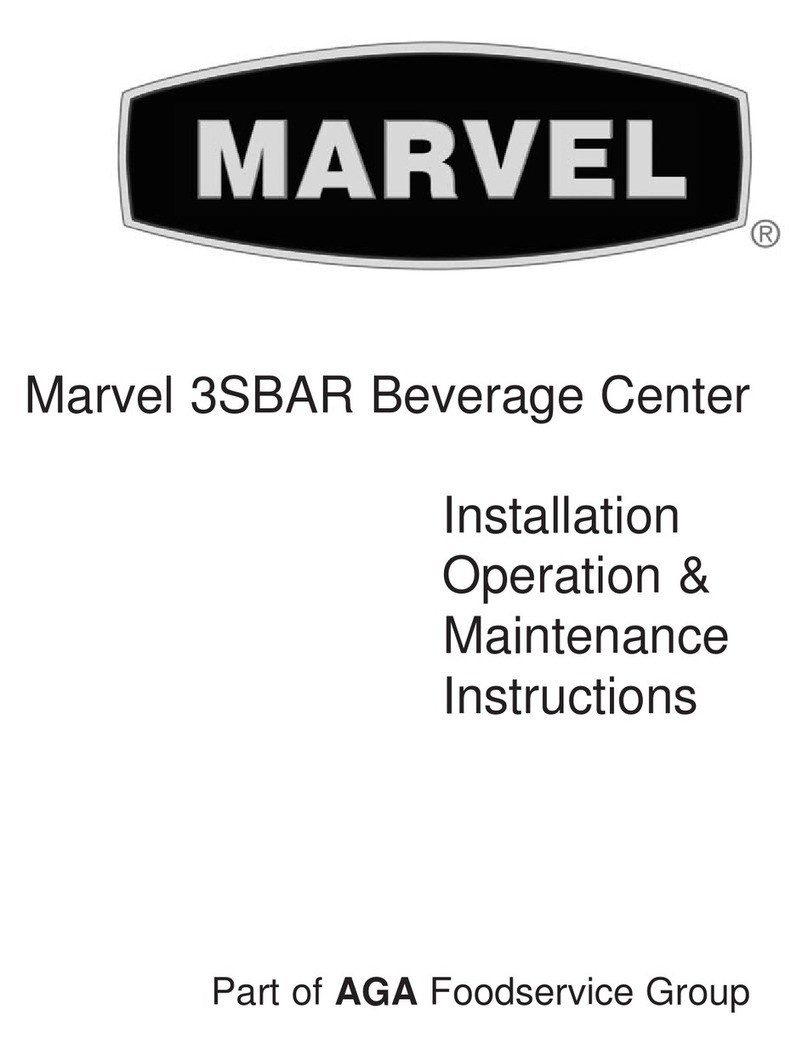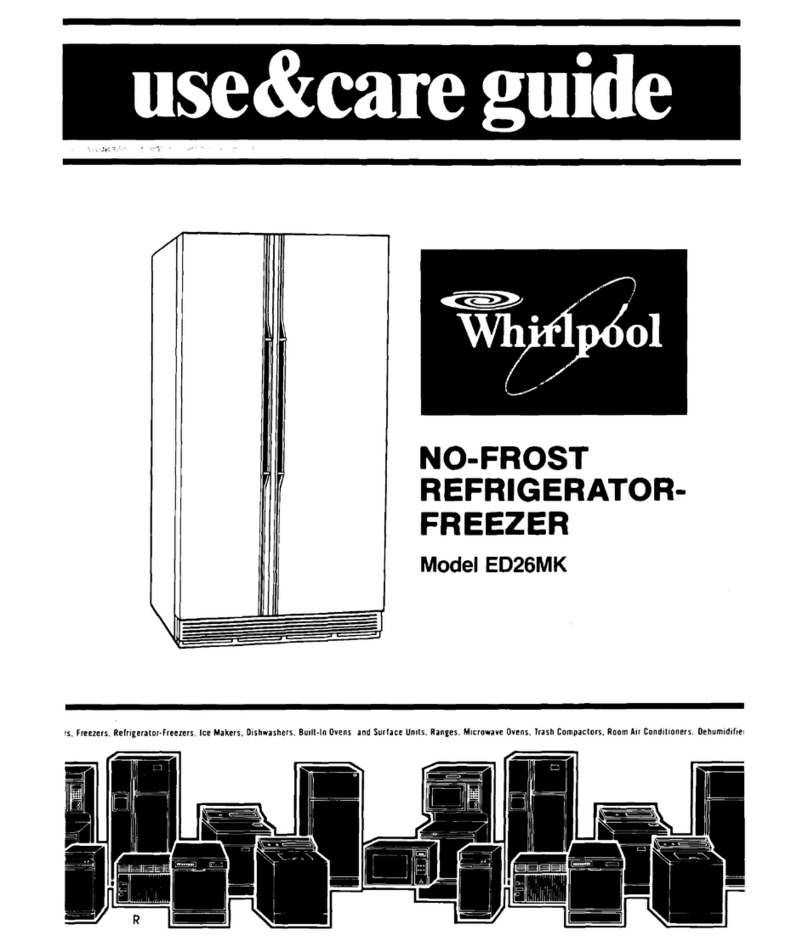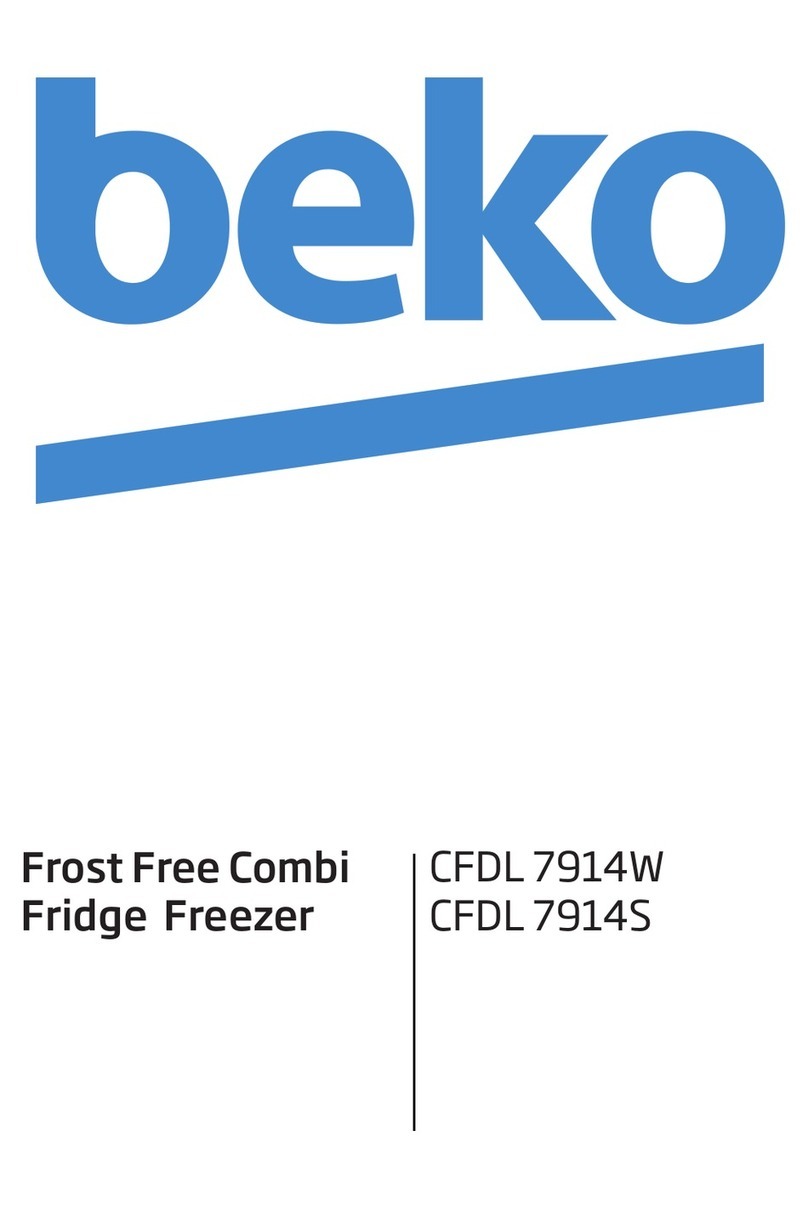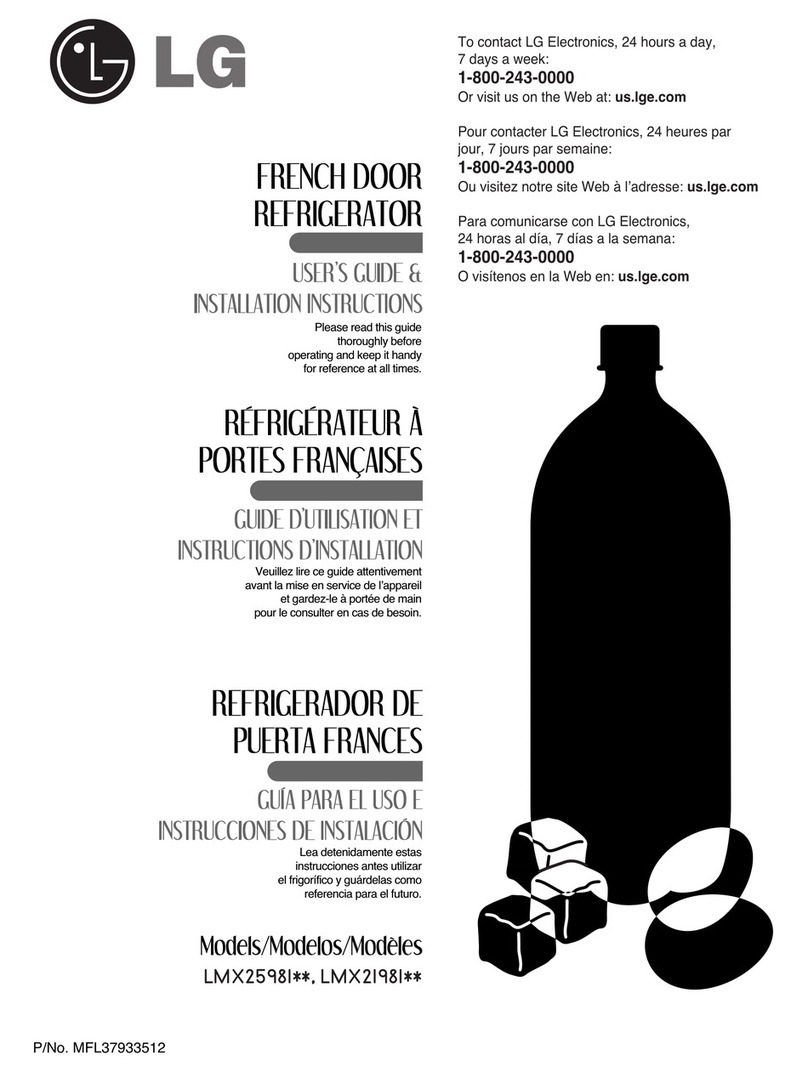Silverline R12069W02 User manual

MODEL
R12069W02
REFRIGERATOR
USER MANUAL
www.silverline.com
FRIGORIFERO
MANUALE UTENTE

Please read the Manual carefully before use.
The Manual shall be kept in good custody for
later reference

CONTENTS
1 Safety warnings
2 Proper use of the refrigerator
3 Structure and functions
4 Maintenance and care of the refrigerator
6 Parameters
5 Trouble shooting

THIS appliance is intended to be used in household and similar applications such as staff kitchen
areas in shops, offices and other working environments; farm houses and by clients in hotels, motels
and other residential type environments; bed and breakfast type environments; catering and similar non-
retail applications.
THIS appliance is not intended for use by persons (including children) with reduced physical,
sensory or mental capabilities, or lack of experience and knowledge, unless they have been given
supervision or instruction concerning use of the appliance by a person responsible for their safety.)
CHILDREN should be supervised to ensure that they do not play with the appliance.
If the supply cord is damaged, it must be replaced by the manufacturer, its service agent or similarly
qualified persons in order to avoid a hazard.
DO not store explosive substances such as aerosol cans with a flammable propellant in this
appliance.
THE appliance has to be unplugged after use and before carrying out user maintenance on the
appliance.
WARNING: Keep ventilation openings, in the appliance enclosure or in the built-in structure,
clear of obstruction.
WARNING: Do not use mechanical devices or other means to accelerate the defrosting
process, other than those recommended by the manufacturer.
WARNING: Do not damage the refrigerant circuit.
WARNING: Do not use electrical appliances inside the food storage compartments of the
appliance, unless they are of the type recommended by the manufacturer.
WARNING: Please abandon the refrigerator according to local regulators for it use flammable
blowing gas and refrigerant.
WARNING: When positioning the appliance, ensure the supply cord is not trapped or
damaged.
WARNING: Do not locate multiple portable socket-outlets or portable power supplies at the
rear of the appliance.
DO not use extension cords or ungrounded two prong adapters.
WARNING: Risk of child entrapment. Before you throw away your old refrigerator or freezer:
-Take off the doors.
-Leave the shelves in place so that children may not easily climb inside.
THE refrigerator must be disconnected from the source of electrical supply before attempting the
installation of accessory.
1
Warningrisk of fire / flammable materials:
1 Safety Warnings
1.1 WARNING

2
REFRIGERANT and cyclopentane foaming material used for the appliance are flammable.
Therefore, when the appliance is scrapped, it shall be kept away from any fire source and be recovered by
a special recovering company with corresponding qualification other than be disposed by combustion,
so as to prevent damage to the environment or any other harm.
FOR EU standard: This appliance can be used by children aged from 8 years and above and
persons with reduce physical sensory or mental capabilities or lack of experience and knowledge if they
have been given supervision or instruction concerning use of the appliance in a safe way and
understand the hazards involved. Children shall not play with the appliance. Cleaning and user
maintenance shall not be made by children without supervision. Children aged from 3 to 8 years are
allowed to load and unload refrigerating appliances.
THE necessity that, for doors or lids fitted with locks and keys, the keys be kept out of the reach
of children and not in the vicinity of the refrigerating appliance, in order to prevent children from being
locked inside .
TO avoid contamination of food, please respect the fo owing instructions:
– Opening the door for long periods can cause a significant increase of the temperature in the
compartments of the appliance.
– Clean regularly surfaces that can come in contact with food and accessible drainage systems.
– Clean water tanks if they have not been used for 48 h; flush the water system connected to a water
supply if water has not been drawn for 5 days. (note 1)
– Store raw meat and fish in suitable containers in the refrigerator, so that it is not in contact with or
drip onto other food.
– Two-star frozen-food compartments are suitable for storing pre-frozen food, storing or making
ice-cream and making ice cubes. (note 2)
– One-, two- and three-sta compa tments are not suitable for the freezing of fresh food. (note 3)
– For appliances without a 4 star c artment: this refrigerating appliance is not suitable for freezing
foodstuffs.(note 4)
– If the refrigerating applianc is le t empty for long periods, switch off, defrost, clean, dry, and leave
the door open to prevent mould developing within the appliance.
Note 1,2,3,4:Please confirm whether it is applicable according to your product compartment type.
FOR a freestanding appliance: this refrigerating appliance is not intended to be used as a built-in
appliance.
ANY replacement or maintenance of the LED lamp is intended to be made by the manufacturer,
its service agent or similar qualified person.
This product contains a light source of energy effi iency class (G ).
WARNING: To avoid a hazard due to instability of the appliance, it must be fixed in accordance
with the instructions.
WARNING: Connect to potable water supply only. (Suitable for ice making machine)
TO Prevent A Child From Being Entrapped, Keep Out Of Reach Of Children And Not In The Vicinity
Of Freezer (Or Refrigerator). (Suitable for products with locks)

3
This manual contains lots of important safety information
which shall be observed by the users.
1 2 Meaning of safety warning symbols
Prohibition symbol
Warning symbol
Note symbol
This is a prohibition symbol.
Any incompliance with instructions marked with
this symbol may result in damage to the product
or endanger the personal safety of the user.
This is a warning symbol.
It is required to operate in strict observance of
instructions marked with this symbol; or otherwise
dmage to the product or personal injury may be caused.
This is a cautioning symbol.
Instructions marked with this symbol require special caution.
Insufficient caution may result in slight or moderate injury,
or damage to the product.
1.3Electricity related warnings
Do not use electrical appliances on the top of the appliance,
unless they are of the type recommended by the manufacturer.
Please use a dedicated power socket and the power socket shall not be
shared with other electrical appliances.
The power plug should be firmly contacted with the socket or else fires
might be caused.
Please ensure that the grounding electrode of the power socket is equipped
with a reliable grounding line.
Do not pull the power cord when pulling the power plug of the refrigerator.
Please firmly grasp the plug and pull out it from the socket directly.
To ensure safe use, do not damage the power cord or use the power cord
when it is damaged or worn.
Please turn off the valve of the leaking gas and then open the doors and
windows in case of leakage of gas and other flammable gases.
Do not unplug the refrigerator and other electrical appliances considering
that spark may cause a fire.

4
1.4 Warnings for using
1.5 Warnings for placement
Do not arbitrarily disassemble or reconstruct the refrigerator,
nor damage the refrigerant circuit; maintenance of the appliance
must be conducted by a specialist
Damaged power cord must be replaced by the manufacturer, its
maintenance department or related professionals in order to avoid
danger.
The gaps between refrigerator doors and between doors and refrigerator
body are small, be noted not to put your hand in these areas to prevent from
squeezing the finger. Please be gentle when close the refrigerator door to
avoid falling articles.
Do not pick foods or containers with wet hands in the freezing chamber when the
refrigerator is running, especially metal containers in order to avoid frostbite.
Do not allow any child to get into or climb the refrigerator; otherwise
suffocation or falling injury of the child may be caused.
Do not put flammable, explosive, volatile and highly corrosive items
in the refrigerator to prevent damages to the product or fire accidents.
Do not place flammable items near the refrigerator to avoid fires.
The refrigerator is intended for household use, such as storage of foods;
it shall not be used for other purposes, such as storage of blood,
drugs or biological products, etc.
Do not place heavy objects on the top of the refrigerator considering
that objectives may fall when close or open the door, and accidental
injuries might be caused.

Do not store beer, beverage or other fluid contained in bottles or
enclosed containers in the freezing chamber of the refrigerator; or
otherwise the bottles or enclosed containers may crack due to
freezing to cause damages.
1)Refrigerating appliances might not operate consistently (possibility of defrosting of contents or
temperature becoming too warm in the frozen food compartment) when sited for an extended
period of time below the cold end of the range of temperatures for which the refrigerating appliance
is designed.
2)The fact that effervescent drinks should not be stored in food freezer compartments or cabinets or
in low-temperature compartments or cabinets, and that some products such as water ices should not
be consumed too cold;
3)The need to not exceed the storage time(s) recommended by the food manufacturers for any kind
of food and particularly for commercially quick-frozen food in food-freezer and frozen-food storage
compartments or cabinets;
4)The precautions necessary to prevent an undue rise in the temperature of the frozen food while
defrosting the refrigerating appliance, such as wrapping the frozen food in several layers of
newspaper.
5)The fact that a rise in temperature of the frozen food during manual defrosting, maintenance or
cleaning could shorten the storage life.
1.6 Warning for energy
Warning for energy
1.7 Warnings for disposal
Refrigerant and cyclopentane foaming material used for the refrigerator are flammable.
Therefore, when the refrigerator is scrapped, it shall be kept away from any fire source and be
recovered by a special recovering company with corresponding qualification other than be
disposed by combustion, so as to prevent damage to the environment or any other harm.
When the refrigerator is scrapped, disassemble the doors, and remove gasket of door and
shelves; put the doors and shelves in a proper place, so as to prevent trapping of any child.
Correct Disposal of this product:
This marking indicates that this product should not be disposed with other household
wastes throughout the EU. To prevent possible harm to the environment or human
health from uncontrolled waste disposal, recycle it responsibly to promote the
sustainable reuse of material resources. To return your used device, please use the
return and collection systems or contact the retailer where the product was purchased.
They can take this product for environmental safe recycling.
5

Before use, remove all packing materials, including bottom cushions,
foam pads and tapes inside of the refrigerator;
tear off the protective film on the doors and the refrigerator body.
Keep away from heat and avoid direct sunlight. Do not
place the freezer in moist or watery places to prevent rust
or reduction of insulating effect.
The refrigerator is placed in a well-ventilated indoor place;
the ground shall be flat, and sturdy (rotate left or right to
adjust the wheel for leveling if unstable).
Do not spray or wash the refrigerator; do not put the refrigerator in
moist places easy to be splashed with water so as not to affect the
electrical insulation properties of the refrigerator.
2.1 Placement
6
2 Proper use of the refrigerator

7

8

9

10

11

12

Light source in this product is replaceable only by qualified engineers.
1. Please take out the
plug before removal.
3. Take down the lamp
panel.
4. Remove the connection
terminal.
2. Remove the lampshade with
a screwdriver.
Any replacement or maintenance of the LED lamps is intended
to be made by the manufacturer,its service agent or similar
qualified person.
After transportation, please let the product stay for more than 2 hours before
turning on the power, otherwise it will lead to a decrease in cooling capacity
or a damage to the product.
Before putting any fresh or frozen foods, the refrigerator shall have run for 2-3
hours, or for above 4 hours in summer when the ambient temperature is high.
Please pull out the plug in case of power failure or cleaning. Do not connect
the freezer to power supply within five minutes to prevent damages to the
compressor due to successive starts.
Organize and label food to reduce door openings and extended searches. Remove as many items
as needed at one time, and close the door as soon as possible.
Appliance storage bin should not be lined with aluminum foil, wax paper, or paper toweling.
Liners interfere with cold air circulation, making the appliance less efficient.
Be sure to wrap foods properly, and wipe containers dry before placing them in the appliance.
This cuts down on frost build-up inside the appliance.
Let hot foods cool to room temperature before placing in the appliance. Overloading the appliance
forces the compressor to run longer. Foods that freeze too slowly may lose quality, or spoil.
The appliance should be located in the coolest area of the room, away from heat producing
appliances or heating ducts, and out of the direct sunlight.
2.6 Energy saving tips
13

14

15

Note: The quick-freezing function is designed to maintain the nutritional value of the food in the freezer. It can
freeze the food in the shortest time. If a large amount of food is frozen at one time, it is recommended that the
user turn on the quick-freezing function and put the food in. At this time, the freezing speed of the freezer
compartment is increased, which can quickly freeze the food, effectively lock the nutrition of the food, and
facilitate storage.
16

4 Maintenance and care of the refrigerator
4.1 Overall cleaning
Please unplug the refrigerator for defrost and cleaning.
Dusts behind the refrigerator and on the ground shall be timely cleaned to improve the cooling effect and
energy saving.
Check the door gasket regularly to make sure there are no debris. Clean the door gasket with a soft cloth
dampened with soapy water or diluted detergent.
The interior of the refrigerator should be cleaned regularly to avoid odor.
Please turn off the power before cleaning interior, remove all foods, drinks ,shelves, drawers, etc.
Use a soft cloth or sponge to clean the inside of the refrigerator, with two tablespoons of baking soda and
a quart of warm water. Then rinse with water and wipe clean. After cleaning, open the door and let it dry
naturally before turning on the power.
For areas that are difficult to clean in the refrigerator (such as narrow sandwiches, gaps or corners), it is
recommended to wipe them regularly with a soft rag, soft brush, etc. and when necessary, combined with
some auxiliary tools (such as thin sticks) to ensure no contaminants or bacterials accumulation in these
areas.
Do not use soap, detergent, scrub powder, spray cleaner, etc., as these may cause odors in the interior of
the refrigerator or contaminated food.
Clean the bottle frame, shelves and drawers with a soft cloth dampened
with soapy water or diluted detergent. Dry with a soft cloth or dry naturally.
Wipe the outer surface of the refrigerator with a soft cloth dampened
with soapy water, detergent,etc., and then wipe dry.
Do not use hard brushes, clean steel balls, wire brushes, abrasives
(such as toothpastes), organic solvents (such as alcohol, acetone,
banana oil, etc.), boiling water, acid or alkaline items, which may
damage the fridge surface and interior. Boiling water and organic
solvents such as benzene may deform or damage plastic parts.
Do not rinse directly with water or other liquids during cleaning to
avoid short circuits or affect electrical insulation after immersion.
detergent
17
Table of contents
Languages:
Other Silverline Refrigerator manuals

